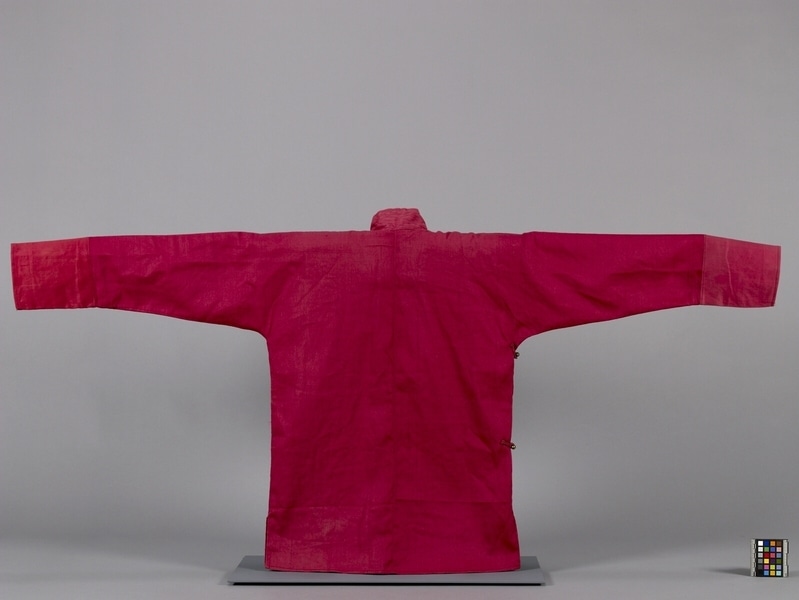Shirt Item Number: 411/136 from the MOA: University of British Columbia


Description
Burgundy men’s shirt of heavy woven cotton with polished outside and felted inside. The shirt has a quilted standing collar, tapered sleeves and side slits. The side opening has metal frog closures engraved with swastikas. There is a pocket on the right inner flap. The inside is unlined. There is a white stamp of the map of India on the inner front.
History Of Use
Weaving in Tibet is the traditional occupation of women. This shirt is typical of shirts common in the Himalayas. The style is known all over central Asia, adopted into China during the Mongol Era. Its origin in the high plateau region is evident in the stylistic details; the long sleeves which partially cover the hands, the double cross of fabric which covers the chest, its length and cut suitable to be worn while riding a horse, all attest to its relation to specific features of the area. The people of the area are equestrians living in a cold climate. The same style may be found in padded or quilted variations. Tibetans have long excelled in the art of dyeing, red being the favoured colour in its various shades. Burgundy is the colour most typically worn by monks and clergy in Tibet (collector's notes).
Cultural Context
worn by men
Iconographic Meaning
Swastika is an ancient Vedic symbol, a cosmic sign.
Narrative
Purchased at the market in Kalimpong town, from Tibetan merchants who cater to Tibetans.
Item History
- Made in Darjeeling, West Bengal, India before 1976
- Collected during 1976
- Owned by Stephen Inglis before December 2, 1977
- Received from Museum of Anthropology Donations Fund (Funding source) and Stephen Inglis (Seller) on December 2, 1977
What
- Name
- Shirt
- Identification Number
- 411/136
- Type of Item
- shirt
- Material
- metal and cotton fibre
- Manufacturing Technique
- woven, machine stitched and hand stitched
- Overall
- height 81.0 cm, width 166.0 cm
Who
- Culture
- Tibetan
- Previous Owner
- Stephen Inglis
- Received from
- Museum of Anthropology Donations Fund (Funding source) and Stephen Inglis (Seller)
Where
- Holding Institution
- MOA: University of British Columbia
- Made in
- Darjeeling, West Bengal, India
When
- Creation Date
- before 1976
- Collection Date
- during 1976
- Ownership Date
- before December 2, 1977
- Acquisition Date
- on December 2, 1977
Other
- Item Classes
- textiles
- Condition
- good
- Accession Number
- 0411/0136